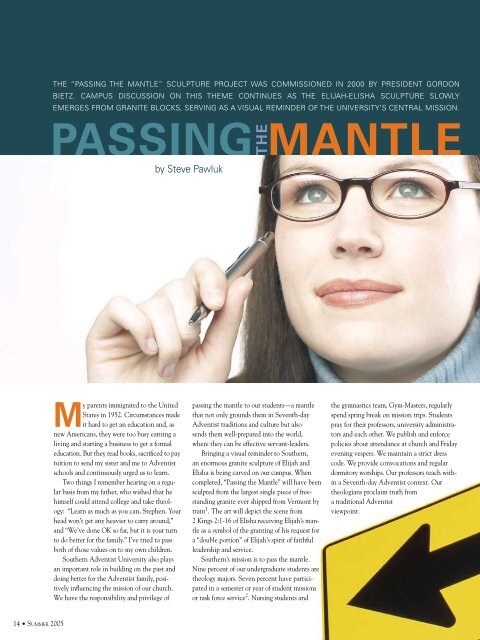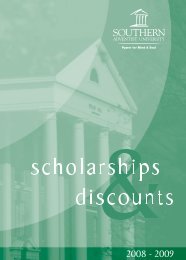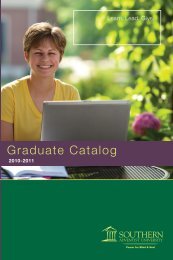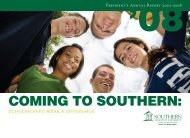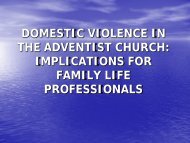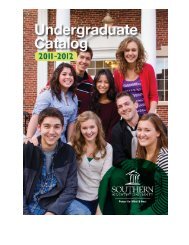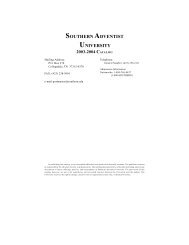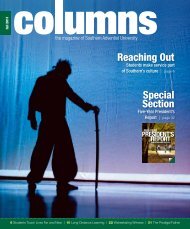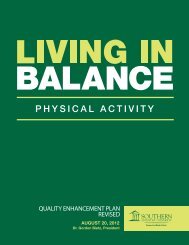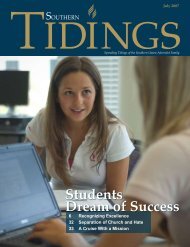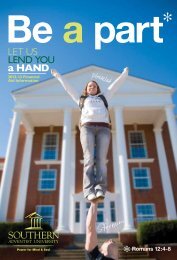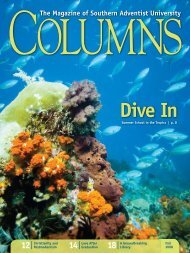PASSING MANTLE - Southern Adventist University
PASSING MANTLE - Southern Adventist University
PASSING MANTLE - Southern Adventist University
You also want an ePaper? Increase the reach of your titles
YUMPU automatically turns print PDFs into web optimized ePapers that Google loves.
The “Passing the Mantle” sculpture project was commissioned in 2000 by president Gordon<br />
Bietz. Campus discussion on this theme continues as the Elijah-Elisha sculpture slowly<br />
emerges from granite blocks, serving as a visual reminder of the university’s central mission.<br />
Passing Mantle<br />
by Steve Pawluk<br />
the<br />
My parents immigrated to the United<br />
States in 1952. Circumstances made<br />
it hard to get an education and, as<br />
new Americans, they were too busy earning a<br />
living and starting a business to get a formal<br />
education. But they read books, sacrificed to pay<br />
tuition to send my sister and me to <strong>Adventist</strong><br />
schools and continuously urged us to learn.<br />
Two things I remember hearing on a regular<br />
basis from my father, who wished that he<br />
himself could attend college and take theology:<br />
“Learn as much as you can, Stephen. Your<br />
head won’t get any heavier to carry around,”<br />
and “We’ve done OK so far, but it is your turn<br />
to do better for the family.” I’ve tried to pass<br />
both of those values on to my own children.<br />
<strong>Southern</strong> <strong>Adventist</strong> <strong>University</strong> also plays<br />
an important role in building on the past and<br />
doing better for the <strong>Adventist</strong> family, positively<br />
influencing the mission of our church.<br />
We have the responsibility and privilege of<br />
passing the mantle to our students—a mantle<br />
that not only grounds them in Seventh-day<br />
<strong>Adventist</strong> traditions and culture but also<br />
sends them well-prepared into the world,<br />
where they can be effective servant-leaders.<br />
Bringing a visual reminder to <strong>Southern</strong>,<br />
an enormous granite sculpture of Elijah and<br />
Elisha is being carved on our campus. When<br />
completed, “Passing the Mantle” will have been<br />
sculpted from the largest single piece of freestanding<br />
granite ever shipped from Vermont by<br />
train 1 . The art will depict the scene from<br />
2 Kings 2:1-16 of Elisha receiving Elijah’s mantle<br />
as a symbol of the granting of his request for<br />
a “double portion” of Elijah’s spirit of faithful<br />
leadership and service.<br />
<strong>Southern</strong>’s mission is to pass the mantle.<br />
Nine percent of our undergraduate students are<br />
theology majors. Seven percent have participated<br />
in a semester or year of student missions<br />
or task force service 2 . Nursing students and<br />
the gymnastics team, Gym-Masters, regularly<br />
spend spring break on mission trips. Students<br />
pray for their professors, university administrators<br />
and each other. We publish and enforce<br />
policies about attendance at church and Friday<br />
evening vespers. We maintain a strict dress<br />
code. We provide convocations and regular<br />
dormitory worships. Our professors teach within<br />
a Seventh-day <strong>Adventist</strong> context. Our<br />
theologians proclaim truth from<br />
a traditional <strong>Adventist</strong><br />
viewpoint.<br />
14 • Summer 2005
But all of this is only a part of the mantle that<br />
we must pass on.<br />
The Bible story of Elijah and Elisha provides<br />
important insight into what it might<br />
mean for the educators of <strong>Southern</strong> to pass<br />
the mantle to their students. I’ve outlined<br />
in the chart on page 16 some lessons from<br />
this story. Please take a few minutes to reflect<br />
on these. If our denomination wishes to<br />
have the same scope of influence, how the<br />
mantle will be passed needs to be very clear.<br />
Enabling a Personal<br />
Connection<br />
First and fundamentally, our mission at<br />
<strong>Southern</strong> is to help our students personally<br />
connect with the Spirit and power of God.<br />
Our privilege as professors and administrators<br />
is to provide an educational environment that<br />
informs, strengthens and challenges students’<br />
allegiance to God. There are times when we<br />
will instruct them in the beliefs, values and<br />
traditions of our denomination. There are other<br />
times when we will ask tough questions and<br />
push them to think critically. 3<br />
Ellen White said, “It is in the water, not<br />
on the land, that [students] learn to swim.” 4<br />
Our goal is neither to indoctrinate students<br />
with our own understandings nor to drown and<br />
discourage them from trying to meet the great<br />
challenges of faith and ministry. Our objective,<br />
as the apostle John states in John 14:6, is to<br />
stimulate students to develop a persistent and<br />
resilient commitment to Truth.<br />
We are striving to ensure that our students<br />
develop a faith and belief system that<br />
is not rigid and brittle like<br />
glass but durable<br />
and elastic, having been “rooted in personal<br />
and critical exploration of alternative goals and<br />
beliefs,” 5 something White said was one of the<br />
main purposes of education.<br />
In fact, White suggests that becoming comfortable<br />
and settled in a safe belief system may<br />
actually be harmful to one’s faith, and she encourages<br />
students of the Scripture to “Agitate,<br />
agitate, agitate.” Failure to critically examine<br />
our beliefs, she warns, will prompt the Lord to<br />
introduce heresies into the church in order to<br />
compel believers to grow. 6 <strong>Southern</strong> is committed<br />
to helping our students grow into mature<br />
and stalwart believers. Passing the mantle<br />
means we will work to enhance our students’<br />
critical thinking skills and provide them with<br />
good practice in effective decision-making.<br />
Norm-referenced tests show that although<br />
<strong>Southern</strong> students score higher than their<br />
public-college counterparts, only 50 percent of<br />
them show proficiency in critical thinking. 7 If<br />
our students are going to accept the mantle, we<br />
need to do better, and we can.<br />
Recognizing Diverse<br />
Experiences<br />
Secondly, we recognize that ministry is not<br />
the same for all believers. White said our ministry<br />
is not our students’, nor is our students’<br />
ministry ours. 8 God calls people to do different<br />
things in different times, circumstances and<br />
places, according to Romans 12:4-6 and 1 Corinthians<br />
12:4-7. And as educators, we want to<br />
be open to the many ways the Spirit works in<br />
and through our students, especially those who<br />
may go beyond our own experiences.<br />
As can be seen from the example of Elisha,<br />
<strong>Southern</strong> graduates may be called<br />
to serve in various venues, including<br />
one-on-one, churches, schools,<br />
the natural environment,<br />
local communities and<br />
national government.<br />
The opportunities for<br />
Christian service<br />
are as diverse<br />
as the personalities<br />
and interests<br />
of our<br />
students. While<br />
many of us grew up in the<br />
days when ministry options were<br />
basically limited to serving the church as<br />
pastors, teachers, doctors<br />
or nurses, today we need<br />
to recommit ourselves<br />
to the broader range of<br />
ministries to which God<br />
may call <strong>Southern</strong> alumni.<br />
Each of our graduates<br />
can, and should,<br />
minister to an important<br />
part of our complex<br />
and needy world. Each<br />
graduate brings a unique<br />
blend of abilities,<br />
understanding, knowledge<br />
and interests into<br />
service. That diversity is a<br />
gift to our world, allowing God to bring the<br />
blessings of His grace to all His children, saved<br />
and unsaved. Some needs will be best met<br />
by our denomination’s organized ministries,<br />
and, as stated in Matthew 5:13 and 14, others<br />
will be best met by committed Seventh-day<br />
<strong>Adventist</strong> individuals who are working, living<br />
and socializing in their secular communities.<br />
To pass the mantle of service, we plan to<br />
review our core general education curriculum,<br />
making sure we help students to develop a broad<br />
understanding of their world and what it means<br />
for thoughtful Christians to live in it. We also<br />
seek to provide service-learning opportunities<br />
that link classroom theories with communitybased<br />
action, developing in students the<br />
desire and ability to engage in service to their<br />
community on an individual and lifelong basis.<br />
Our core curriculum must also ensure<br />
that each alumnus of <strong>Southern</strong> possesses the<br />
knowledge, skills, attitudes and abilities to<br />
exercise leadership. We know that many of<br />
our students will, after earning their degrees,<br />
relocate to small towns and become members<br />
of the local churches. Many of these churches<br />
need deacons, elders, speakers, teachers and<br />
board members who can provide informed<br />
leadership. Some churches will have K-8<br />
schools associated with their ministry. Those<br />
schools will need board members who are able<br />
to make good financial and fair personnel<br />
decisions as well constituents who are creative<br />
fund raisers and problem solvers. Those<br />
churches will be a part of the local community,<br />
and <strong>Southern</strong>’s Elishas must be able to<br />
participate in and organize a variety of civic<br />
projects and public events, bringing grace to<br />
their neighborhoods.<br />
Columns • 15
LESSONS FROM ELIJAH AND ELISHA<br />
1 Kings 19:19, 2 Kings 2:13-15 and<br />
the “Seventh-day <strong>Adventist</strong> Bible<br />
Commentary”<br />
2 Kings 2:14<br />
1 Kings 19:21 and the “Seventh-day<br />
<strong>Adventist</strong> Bible Commentary”<br />
Elijah’s mantle served as a tangible symbol of Elijah’s initial call of Elisha to<br />
selfless ministry and, upon Elijah’s ascension, the passing of his leadership<br />
role to Elisha.<br />
Elisha clearly understood that the mantle was not magical or authoritative<br />
in itself but simply served as a physical symbol of the power of God’s Spirit<br />
working through him. Elisha’s ministry was both different from, and more<br />
extensive than, that of Elijah’s.<br />
Even as an intern, Elisha improved Elijah’s ministry.<br />
2 Kings 2–13, “Prophets and Kings”<br />
and 2 Kings 13:20-21<br />
John 14:12<br />
2 Kings 6:1-2<br />
2 Kings 2:19-22<br />
2 Kings 4:1-37 and 5:1-6:7<br />
2 Kings 6:8-23; 13:14-19<br />
Elisha did, in fact, finally receive a double portion of the Spirit and surpassed<br />
the work of his mentor and teacher, both while living and after his death.<br />
The next generation can do better for the family of God.<br />
Elisha’s ministry influenced the schools of the prophets.<br />
Elisha’s ministry influenced the natural environment.<br />
Elisha’s ministry influenced individuals.<br />
Elisha’s ministry influenced society and national security.<br />
Visually Representing <strong>Southern</strong>’s Mission by Heidi Martella, ‘05<br />
Tucked behind Miller Hall, two granite blocks<br />
are cut, wedged, jet-blasted and ground into the<br />
resemblance of Elijah passing his mantle to Elisha.<br />
In a few years the statues will adorn the campus<br />
as a symbol of what the institution stands for:<br />
passing along information from the older generation<br />
to the younger.<br />
An Idea Is Born<br />
Art Professor Maria Hazen suggested the School<br />
of the Prophets as a theme.<br />
The suggestion caught on, especially after<br />
Gordon Bietz shared a quote from Albert Myer:<br />
“Education is a conversation between the older and<br />
younger generations on what is important.”<br />
This theme continued to take shape with the<br />
idea to create a sculpture of the account of Elijah<br />
passing his mantle to Elisha before he ascended<br />
into heaven.<br />
“The sculpture will be a symbol of a teacher<br />
passing information along to the pupil,” says Ben<br />
Wygal, chair of the <strong>University</strong>’s Fine Art Committee.<br />
Finding the Rock<br />
Hazen scouted out nearby areas to obtain granite.<br />
He soon discovered that quarries in Tennessee<br />
and Georgia didn’t have the equipment to cut and<br />
deliver the desired size of granite.<br />
Hazen grew up near the Rock of Ages quarry<br />
in Barre, Vermont, and remembered seeing large<br />
pieces of granite. The first stone for Elisha, weighing<br />
40 tons, was cut, transported and delivered to<br />
<strong>Southern</strong>’s campus in 2001.<br />
The process was repeated when a 20-foot piece<br />
of granite was drilled out of the ground in 2003.<br />
The granite slab sat at the quarry for a year as<br />
crews worked to rebuild a road to transport the<br />
83-ton block to the railhead. At last the road was<br />
ready for heavy-duty tractor-trailers to transport<br />
the largest single piece of granite ever taken out of<br />
the quarry to the railhead.<br />
A Work in Progress<br />
Between his responsibilities as dean of the<br />
School of Visual Art & Design and as an art professor,<br />
Hazen has limited time to work on the sculpture<br />
each week.<br />
His work process is long and complicated. He<br />
started with developing three or four models,<br />
which give an “incomplete road map” for the project.<br />
From the models, he created computer images<br />
to obtain specific information about where and<br />
how deep to drill. Using various tools such as a<br />
jet-stik (a hand-held torch that uses propane and<br />
oxygen to produce a 5,000˚ flame) and diamond<br />
grinding bits, Hazen shapes the statues within 2<br />
inches of the finished product. By the time the<br />
sculpture elements are at their final sizes, they<br />
will weigh 20 to 30 percent less than before.<br />
The committee is still considering the final<br />
location for the sculptures. No matter the location,<br />
when “Passing the Mantle” is finished, it will<br />
be the visual representation of <strong>Southern</strong>’s mission<br />
to provide a learning community while nurturing<br />
Christ-likeness and encouraging the pursuit of<br />
truth, wholeness and a life of service.<br />
16 • Summer 2005
“We are striving to ensure that<br />
our students develop a faith<br />
and belief system that is not<br />
rigid and brittle like glass, but<br />
that is durable and elastic.”<br />
Instilling Responsibility<br />
for Service<br />
Thirdly, passing the mantle means <strong>Southern</strong><br />
will help its alumni understand that the educational<br />
opportunities and degrees awarded at<br />
<strong>Southern</strong> constitute a sacred trust for the public<br />
benefit. According to the U.S. Census, only<br />
about 16 percent of the population over age 25<br />
holds a four-year college degree. 9 Instead of being<br />
a cause for personal pride, a <strong>Southern</strong> degree carries<br />
with it an obligation for civic involvement.<br />
A <strong>Southern</strong> degree is obtained with public<br />
support. Denominational subsidies, grants and<br />
scholarships, taxpayer-subsidized student loans,<br />
alumni gifts, family financial contributions,<br />
tax benefits for college tuition paid and<br />
professors’ and administrators’ willingness<br />
to work for extremely modest salaries are<br />
combined with the student’s own academic<br />
efforts and tuition dollars. A college education<br />
represents a community’s investment in each<br />
student. There are no exceptions. Between<br />
30 and 70 percent of the cost of any student’s<br />
education is supported by the extended<br />
community. And that investment expects a<br />
return. While secular higher education also<br />
expects a beneficial contribution to be made<br />
to the community, Christian higher education<br />
prepares graduates for the responsibility of<br />
civic engagement resulting from faith and<br />
leadership made possible by the benefits of a<br />
higher education.<br />
Sending Them Into the World<br />
Finally, those of us who pass the mantle<br />
must recognize that approximately four short<br />
years after a student first comes to our university,<br />
he or she will leave. We believe that the<br />
best way for a <strong>Southern</strong> graduate to go into the<br />
world is to be wrapped in the mantle, standing<br />
on his or her own two feet, eyes to the future,<br />
heart firmly fixed on God, well-prepared to<br />
serve and lead at home, in the church, at the<br />
local school, in the community and throughout<br />
the global mission field. While four years is not<br />
very much time, it’s enough to pass the mantle<br />
and further God’s work.<br />
1 The Barre Grey granite weighs 166,000 pounds and was shipped<br />
by Rock of Ages, a Vermont-based quarry, according to a front-page<br />
story in The <strong>Southern</strong> Accent, October 28, 2004. Wayne Hazen, dean<br />
of the School of Visual Art & Design, is the sculptor.<br />
2 The records office reports that during the 2004–2005 school<br />
year we enrolled 202 theology majors with a total enrollment of<br />
2,238. The chaplain’s office reports that 82 students served as<br />
student missionaries and 18 students served as task force workers<br />
during the year. We also had 44 returned student missionaries and<br />
task force workers on campus.<br />
3 Most educators agree that learning cannot take place without the<br />
presence of at least some cognitive dissonance. Elijah demonstrated<br />
a type of cognitive dissonance when he “commanded” Elisha not to<br />
follow him any longer. 1 Kings 19:20, 21 and 2 Kings 2:2, 4, 6; cf White,<br />
E. G. “Prophets and Kings,” pp. 220, 225. Ellen White also encourages<br />
its use in “Testimonies to the Church, Volume 5” pp. 707, 708.<br />
4 White, “Education,” p. 268<br />
5 This description of students’ faith is taken from Pacific Union<br />
College President Richard Osborn’s presentation, entitled “Living<br />
Athens and Jerusalem: Response to Higher Education Administration<br />
When Academic Freedom Challenges the Church,” given at the Second<br />
International Faith and Science Conference in August 2004.<br />
6 White, “Testimonies for the Church, Volume 5,” pp. 707,708<br />
7 In November 2003, <strong>Southern</strong> administered the long form of the<br />
academic profile assessment sponsored by the College Board and the<br />
Educational Testing Service. Our director of Institutional Research<br />
and Planning reported that 50 percent of our seniors earned a score<br />
of not proficient and that nationally, 74 percent of college students<br />
earned a score of not proficient.<br />
8 White, “Education,” pp. 262, 267<br />
9 Table QT-P20. Educational Attainment by Sex: 2000 at factfinder.<br />
census.gov<br />
Columns • 17


